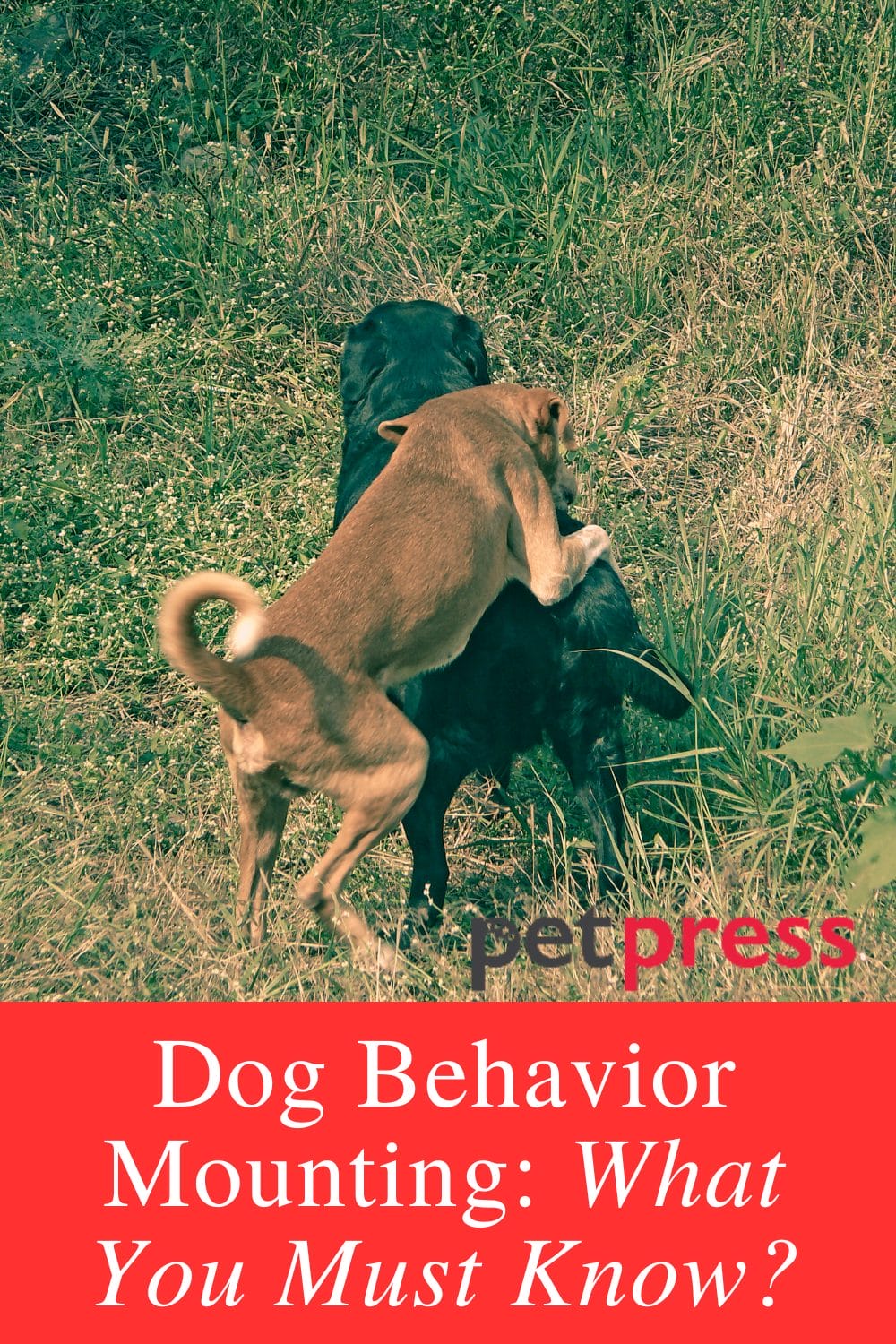
Dogs are fascinating creatures with a wide range of behaviors that can both charm and puzzle their owners. One such behavior that often perplexes dog owners is mounting.
This article will explore dog mounting behavior, including its causes, when it becomes problematic, and how to manage it effectively. Let’s start the journey to understand this often misunderstood behavior.
What is dog behavior mounting?
Dog mounting, also known as humping, is a natural behavior where one dog places paws on another dog’s back or engages in sexual activity. It can also involve mounting inanimate objects like toys or pillows.
Both male and female dogs exhibit this behavior, regardless of being spayed or neutered. While normal to some extent, excessive or inappropriate mounting can raise concerns for pet owners.
While mounting is common in many dogs, it doesn’t mean every dog will exhibit this behavior. Just like humans, each dog has its own personality and behavior patterns. Some dogs may frequently engage in mounting, while others may hardly or never show this behavior.

Reasons Behind Mounting Behavior
Sexual Behavior
Sexual instincts often drive mounting behavior in dogs. Unspayed or unneutered dogs, especially those in heat, are more prone to this behavior.
Puppies may also exhibit mounting as they explore their bodies and sexual behaviors. However, it’s important to note that not all mounting instances are solely driven by sexual desires.
Dominance and Hierarchy
Mounting can occur in dogs as a display of dominance or an attempt to establish hierarchy. Untrained or inadequately socialized dogs may use mounting to assert control.
Proper training and socialization can minimize mounting behavior and promote a harmonious dog environment.
Playfulness and Excitement
Mounting can sometimes be a playful or exciting behavior in dogs, often seen in puppies during energetic moments. Dogs may mount others during playtime to show enthusiasm and interact with their companions.
It’s important to note that this behavior is not necessarily about dominance or aggression but rather about dogs’ natural exuberance and social dynamics.
Stress and Anxiety
Stress and anxiety can affect dogs in various ways, including excessive barking, destructive behavior, and mounting. When one dog places its forelegs on another dog’s back, mounting can be a coping mechanism for dogs in emotional distress.
Dog owners should recognize and address the underlying causes of mounting behavior to ensure their furry companions’ overall well-being and emotional health.
When does mounting become a problem?
While occasional mounting is considered normal, it becomes problematic when it occurs excessively, becomes aggressive, or leads to discomfort for the recipient.
Understanding the context and triggers is crucial in determining if intervention is necessary.

Understanding the Different Types of Mounting
Mounting Objects
Dogs may display mounting behavior towards inanimate objects such as pillows, toys, or furniture. This can result from pent-up energy, boredom, or simply a habit.
Mounting People
Mounting humans can be embarrassing and uncomfortable for owners. Addressing this behavior promptly is essential to preventing any potential social discomfort.
Mounting Other Dogs
Mounting between dogs can occur for various reasons, including establishing dominance, playfulness, or overstimulation. It’s essential to observe the body language of both dogs involved to gauge the nature of the interaction.

Training and Correcting Mounting Behavior
Addressing mounting behavior requires patience, consistency, and positive reinforcement.
Positive Reinforcement
Treats, praise, and positive reinforcement techniques can effectively redirect your dog’s behavior. By rewarding desired actions and behaviors with treats and verbal encouragement, you can create a positive association and motivate your dog to repeat those behaviors.
Additionally, incorporating training sessions into your daily routine can help establish clear communication and strengthen your bond with your furry friend. Consistency and patience can shape your dog’s behavior and foster a harmonious relationship.
Redirecting Attention
Interrupting the mounting behavior and redirecting your dog’s attention toward an appropriate activity can be an effective strategy to break the cycle. Providing a clear and engaging alternative, such as offering a puzzle toy or initiating a play session, can help redirect your dog’s focus and energy positively and constructively.
This helps prevent the mounting behavior from persisting, promotes mental stimulation, and reinforces desired behaviors. Remember, consistency and patience are key when implementing this approach.
Consistency in Commands
Establishing clear commands like “sit” or “stay” and consistently reinforcing them can significantly contribute to curbing mounting behavior over time. Dogs can learn to associate these commands with appropriate behavior, leading to better obedience.
This consistent reinforcement and training can gradually shape desired behavior patterns, ultimately helping to prevent or reduce mounting behavior in the long run.
Seeking Professional Help
In severe cases or if the problematic behavior persists despite initial efforts, seeking guidance from a professional dog trainer or behaviorist is highly recommended. These experts understand the underlying causes and develop tailored strategies to address the issue effectively.
By working closely with a professional, you can gain valuable insights and practical advice to ensure the well-being of your furry companion.

Preventing Mounting Behavior
Neutering/Spaying
Having your dog neutered or spayed can significantly reduce mounting behavior, mainly if sexual motivations drive it.
Neutering or spaying not only affects a dog’s sexual behavior but also reduces aggression and dominance, which can contribute to mounting. However, it’s important to note that these procedures don’t guarantee an end to mounting behavior, especially if your dog has learned to mount in response to stress, excitement, or as a form of social communication.
A dog’s behavior is influenced by both nature and nurture. Consistent training and positive reinforcement are crucial for managing and preventing mounting behavior.
Every dog is unique, and consulting a trusted veterinarian is essential when considering neutering or spaying. Factors like age, health, and behavior should be taken into account.
Providing Adequate Exercise
Regular exercise is vital for managing and preventing mounting behavior in dogs. A bored or restless dog with excess energy may mount to alleviate it.
Daily walks, play sessions, or dog sports can help burn off that energy. The intensity and duration of activity depend on your dog’s breed, age, and health.
High-energy breeds may need running or agility training, while older or less active breeds can enjoy leisurely walks or gentle play. Mental stimulation is also crucial. Puzzle toys, training sessions, or interactive games can reduce restlessness and unwanted behavior.
Remember, a well-exercised dog is healthier and happier, leading to better behavior and a harmonious relationship with your furry companion.
Socialization and Playtime
Allowing your dog to interact with other dogs in a controlled environment can help them learn appropriate social behaviors. This can include supervised playdates, visits to the dog park, or group training classes.
Your furry friend can learn valuable social cues and proper communication through positive interactions. This promotes good behavior and helps prevent mounting behavior as a form of communication or play.
Remember to monitor their behavior and intervene if necessary. Proper socialization can prevent or reduce problematic behaviors in your dog.
Mental Stimulation
Just as physical exercise plays a part in keeping your dog’s behavior in check, mental stimulation also has a crucial role. It’s often said that ‘a tired dog is a good dog’, but this doesn’t just refer to physical tiredness. Keeping your dog’s mind active and engaged can significantly deter mounting behavior.
Puzzle toys, for instance, are a great way to challenge your dog mentally. This can keep their mind focused on the task rather than mounting.
Similarly, training sessions that involve learning new commands or tricks can stimulate your dog’s cognitive functions, keeping their mind occupied and reducing the tendency towards undesirable behaviors.
Interactive games, such as hide-and-seek or fetch, can serve a dual purpose. They provide physical exercise while engaging your dog’s mind, as they must understand and follow the game’s rules.

5 FAQs About Dog Mounting Behavior
- Is mounting behavior only seen in male dogs?
No, mounting behavior can be exhibited by both male and female dogs. While it may be more commonly associated with male dogs due to their higher testosterone levels, females can also engage in this behavior for various reasons.
2. Can neutering or spaying eliminate mounting behavior?
Neutering or spaying your dog can significantly reduce mounting behavior, particularly when driven by sexual motivations. However, these procedures cannot guarantee the complete elimination of such behavior.
3. Is mounting always a form of sexual behavior?
No, mounting can have various motivations and may not always be related to sexual desires. Dogs might mount for reasons such as excitement or dominance.
4. Can training stop my dog from mounting?
Training can help manage and prevent mounting behavior, but it is not a one-size-fits-all solution. It’s essential to understand the underlying reasons behind the behavior and address them accordingly.
5. Is mounting a sign of aggression?
Not necessarily. While mounting can be used as a form of dominance or control, it can also be seen in playful or excited contexts. It’s crucial to observe the context in which the behavior occurs and understand its true motivation.
Knowing the facts about mounting behavior can help you better understand and manage this common dog issue. By providing appropriate mental stimulation, debunking myths, and addressing underlying causes, you can help your dog lead a happier and healthier life.
Conclusion
Understanding and addressing dog mounting behavior requires patience, training, and, sometimes, professional guidance. By recognizing the underlying causes and implementing appropriate strategies, you can effectively manage this behavior, ensuring a harmonious relationship between you and your furry companion.


GIPHY App Key not set. Please check settings